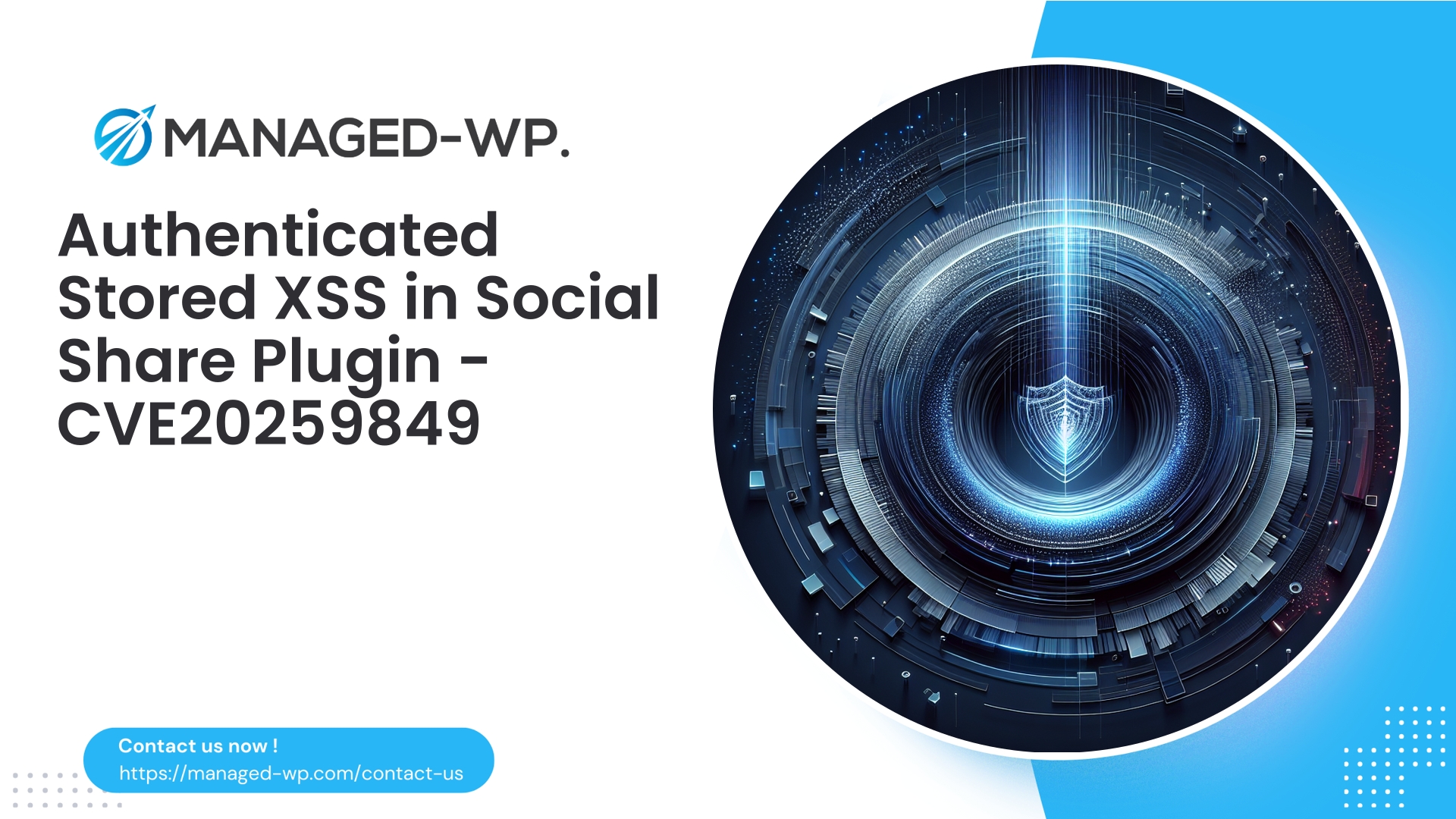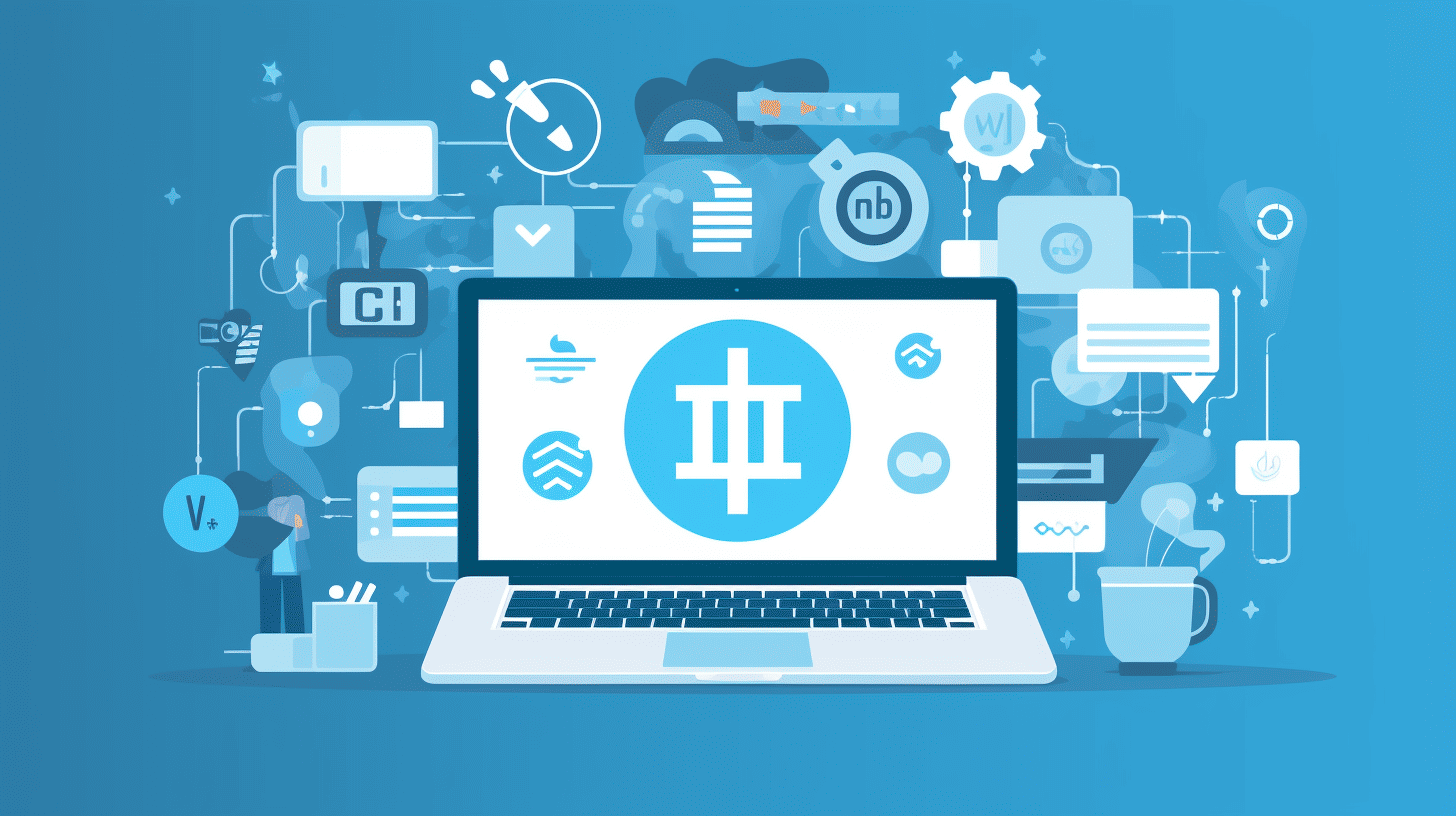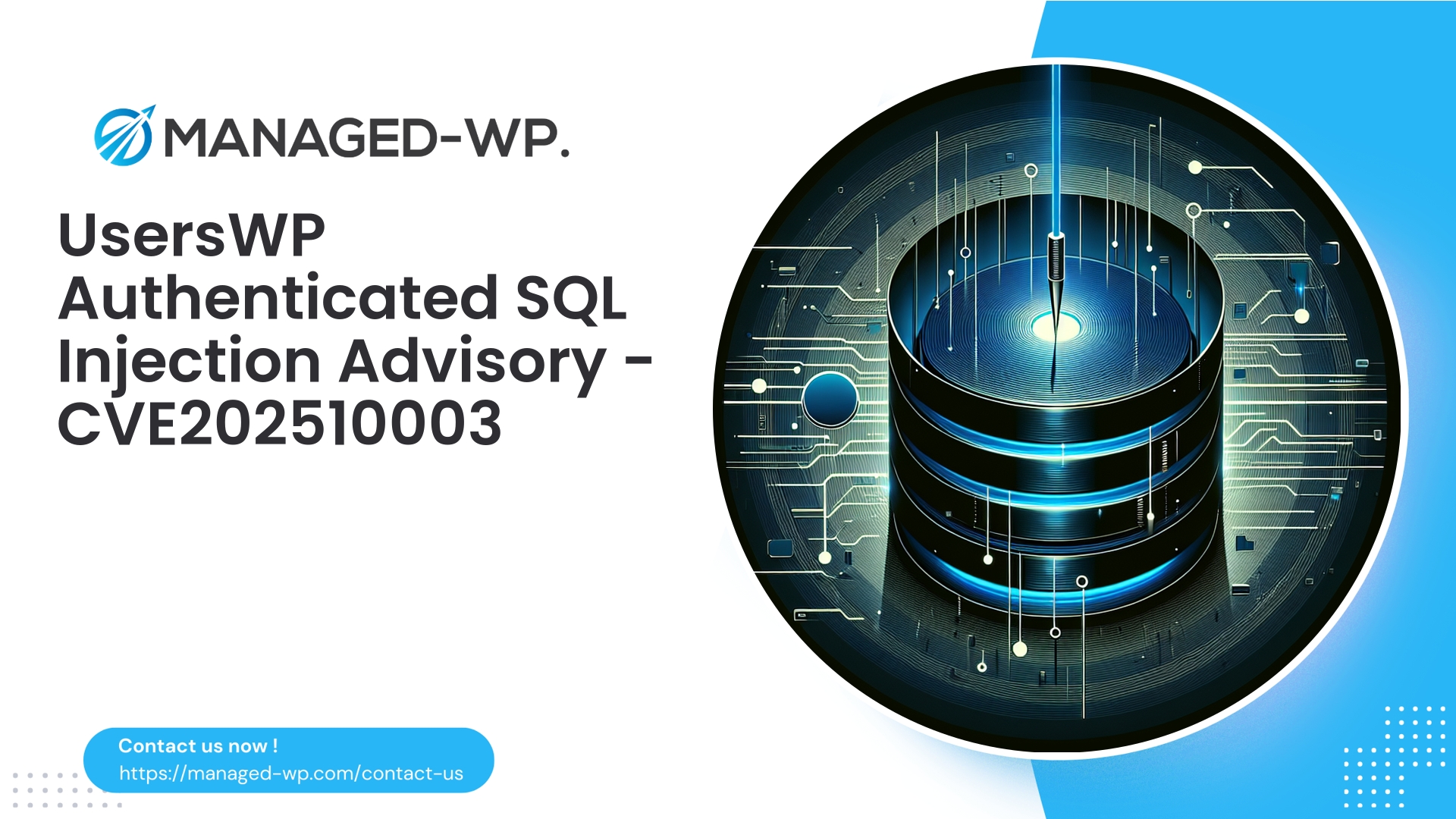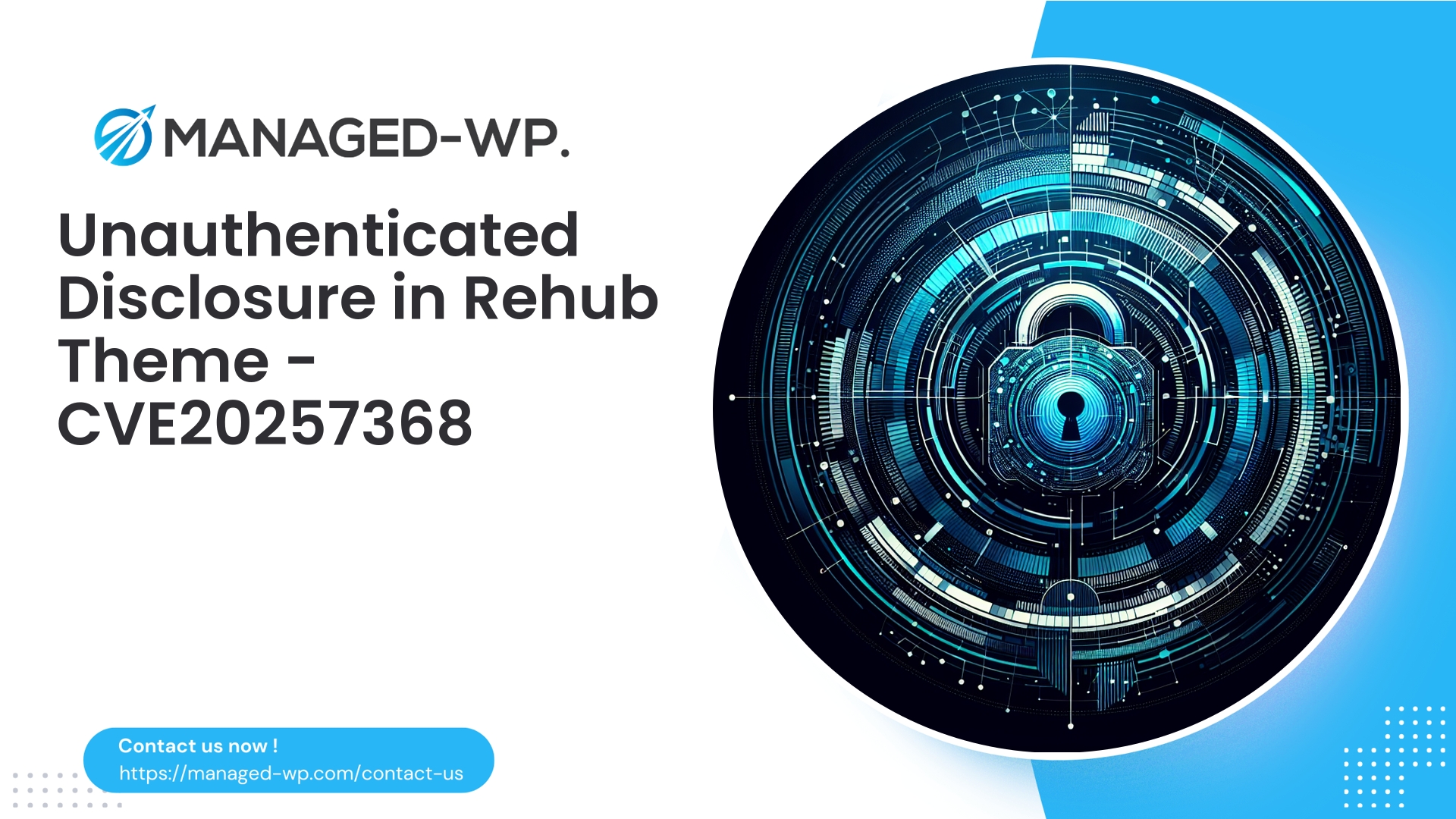| Plugin Name | Html Social share buttons |
|---|---|
| Type of Vulnerability | Authenticated Stored Cross Site Scripting |
| CVE Number | CVE-2025-9849 |
| Urgency | Low |
| CVE Publish Date | 2025-09-05 |
| Source URL | CVE-2025-9849 |
Urgent Security Advisory: Authenticated Contributor Stored XSS in Html Social Share Buttons Plugin (≤ 2.1.16, CVE-2025-9849)
Published: September 5, 2025
CVE Reference: CVE-2025-9849
Affected Plugin: Html Social Share Buttons (WordPress)
Vulnerable Versions: 2.1.16 and earlier
Patch Available: Version 2.2.0
Required Privilege: Contributor Role
CVSS Severity: 6.5 (Medium)
Security Research Credit: Peter Thaleikis
WordPress site owners and security professionals should be aware of a recently disclosed security vulnerability impacting the Html Social Share Buttons plugin. Versions up to and including 2.1.16 contain a stored cross-site scripting (XSS) flaw that allows authenticated users with Contributor-level access to inject persistent malicious JavaScript. This script executes within the context of visitors or administrators when they view affected pages, posing a serious risk, including session hijacking and privilege escalation.
This Managed-WP advisory provides a comprehensive overview of the vulnerability, practical mitigation steps, and professional recommendations to protect your WordPress environment effectively.
Executive Summary for Site Owners & Administrators
- Issue: The Html Social Share Buttons plugin allows contributors to inject and store malicious JavaScript, which executes when others view the affected content.
- Who’s at risk: Any WordPress site running versions ≤ 2.1.16 of the plugin, especially those with multiple contributor accounts or community-sourced content.
- Potential consequences: Exploitation can lead to cookie theft, admin account compromises, unauthorized redirects, content defacement, and increased attack surface for further intrusion.
- Immediate mitigation: Update the plugin to version 2.2.0 or above. If immediate updates aren’t possible, implement Web Application Firewall (WAF) rules to block malicious payloads and audit contributor-generated content.
- Long-term recommendations: Enforce stricter user role capabilities, restrict raw HTML posting to trusted users, deploy continuous managed WAF protection, and maintain routine malware scans.
Understanding the Significance of Contributor-Level Stored XSS
Though contributors lack publishing authority, their ability to save drafts or pending posts creates an attack vector for stored XSS. This vulnerability is especially dangerous because:
- Stored XSS payloads persist in the database and trigger in browsers of editors, admins, and regular visitors.
- Unsanitized contributor input can include malicious event handlers or scripts embedded in post content or shortcode parameters.
- Once active, attackers can execute arbitrary JS code, enabling session hijacking, data theft, or privilege escalation if admins interact with the compromised content.
Managed-WP strongly advises not to downplay risks linked to contributor roles.
Technical Overview of the Vulnerability
The stored XSS arises due to insufficient input sanitization and output escaping within plugin components that accept user input. Contributors can inject harmful elements because:
- User input containing script tags or dangerous attributes is received without proper sanitization.
- This input is stored verbatim in the database.
- The plugin outputs this raw data directly into pages without escaping special characters, enabling browsers to execute embedded scripts.
- Because the input vector is accessible at contributor level, even lower-privileged users can exploit this flaw.
Exploitation Scenarios
- Contributors crafting posts or widget content embedding malicious JavaScript payloads.
- Injection of scripts into plugin option fields if accessible to contributor roles.
- Stealing authentication cookies when administrators preview compromised content, facilitating back-end access.
- Loading additional malware via external sources, allowing persistent or multi-stage attacks.
Note: Stored XSS remains a popular technique for lateral movement in multi-author WordPress systems.
Indicators of Compromise (IoCs) to Monitor
- Presence of <script> tags or inline event handlers in contributor-created content, drafts, or plugin options.
- Unusual JavaScript embedded in social share buttons or related plugin output.
- Unexpected browser behavior such as pop-ups, redirects, or console errors linked to loaded posts/pages.
- Suspicious POST requests containing HTML payloads from contributor accounts targeting plugin endpoints.
- New or unknown administrative users or scheduled tasks appearing after content updates.
Ensure timely capture and forensic analysis of logs and content if compromise is suspected.
Immediate Mitigation Actions (0–24 Hours)
- Upgrade: Apply the official patch by updating to Html Social Share Buttons version 2.2.0 or above.
- If update is delayed:
- Temporarily restrict contributor posting privileges or disable contributor accounts.
- Disable the vulnerable plugin temporarily if feasible.
- Enable maintenance mode to limit exposure during investigations.
- Deploy WAF or virtual patching measures to block script injection patterns originating from contributor input.
- Audit all recent contributor-generated content for suspicious HTML or script fragments; sanitize or remove as needed.
- Inform editorial and site maintenance teams to increase vigilance on incoming user content.
Recommended Follow-Up Actions (24–72 Hours)
- Perform comprehensive malware scans and forensic database inspections.
- Review and revert compromised post revisions or plugin options identified as malicious.
- Rotate all potentially affected credentials, including admin, editor, and contributor accounts.
- Search for and remove any backdoors, suspicious scheduled tasks, or unauthorized admin accounts.
- Restore from clean backups if malware persistence cannot confidently be cleared.
Detecting Exploitation Attempts via Logs and WAF Monitoring
- Monitor POST requests to admin and widget endpoints made by contributor users containing HTML/JS payloads.
- Track front-end requests that trigger connections to unknown external domains.
- Analyze WAF logs for blocked attempts matching stored XSS attack signatures.
- Generate alerts on administrative content previews that initiate outbound requests to suspicious hosts.
Sample WAF Signatures for Virtual Patching (Conceptual Examples)
ModSecurity-style rule outline:
# Block inline script attempts on wp-admin endpoints
SecRule REQUEST_URI "@contains /wp-admin/" \
"phase:2,chain,deny,status:403,msg:'Block stored XSS - Html Social Share Buttons'"
SecRule ARGS|ARGS_NAMES|REQUEST_COOKIES|XML:/* "(?i)(<\s*script\b|javascript:|on\w+\s*=|document\.cookie|eval\()" \
"t:none,t:urlDecode,t:lowercase,logdata:%{MATCHED_VAR},id:1009001"
Plugin-specific tighter check:
# Target plugin widget update and options endpoints for suspicious inputs
SecRule REQUEST_URI "@rx /wp-admin/options.php|/widgets/|/admin-ajax.php" \
"phase:2,chain,deny,msg:'Block suspicious contributor HTML input',log"
SecRule ARGS_NAMES|ARGS "(?i)(plugin_option_name|html_social_share|share_buttons|shortcode_attr)" \
"chain"
SecRule ARGS "(?i)(<\s*script\b|on\w+\s*=|javascript:|document\.cookie|eval\()" "deny,log"
Best practices:
- Begin in “log only” mode to calibrate false positives.
- Leverage HTML whitelisting on the server side for permitted tags/attributes.
- Use role-based exceptions (e.g., allow trusted admins to submit raw HTML).
Secure Development Practices for Plugin/Theme Authors
Developers maintaining plugin or theme code should focus on sanitization and escaping at necessary stages:
- Sanitize all user input before storage (e.g.,
sanitize_text_field(),wp_kses()with strict allowed tags). - Escape output at render time with functions like
esc_html(),esc_attr(), andesc_url(). - Restrict raw HTML editing capabilities to trusted roles only.
- Never echo user-supplied data directly into HTML attributes or scripts unfiltered.
Example safe input processing:
<?php
// Sanitize user-provided label on save
$clean_label = wp_kses( $_POST['share_label'], array(
'a' => array( 'href' => true, 'title' => true, 'rel' => true ),
'span' => array( 'class' => true ),
));
update_option( 'plugin_share_label', $clean_label );
// Escape output safely
echo wp_kses_post( get_option( 'plugin_share_label' ) );
?>
Security Hardening Recommendations for WordPress Site Owners
- Apply security patches promptly.
- Enforce least privilege: Limit contributor role usage and restrict raw HTML posting.
- Require Multi-Factor Authentication for editors and administrators.
- Employ managed WAF solutions offering virtual patches against known and emerging threats.
- Enable automatic updates where feasible to accelerate security fixes deployment.
- Maintain and test backups regularly to minimize downtime after an incident.
- Monitor logs and trigger alerts on suspicious activity from non-admin users.
- Schedule periodic security audits and malware scanning sessions.
Incident Response Checklist if You Suspect Exploitation
- Isolate affected systems by disabling the vulnerable plugin or taking the site offline temporarily.
- Preserve audit logs, database dumps, and copies of suspicious files for investigation.
- Identify malicious content by searching for scripts and suspicious code in posts and options.
- Remove or revert malicious content to clean versions.
- Scan and clean for backdoors, malicious cron entries, or unauthorized accounts.
- Rotate all relevant passwords and API keys.
- Restore from a clean backup if uncertainty remains.
- Implement updated plugins, WAF rules, and tighten role permissions before bringing the site back online.
- Notify your team and stakeholders as appropriate based on impact and policy requirements.
WAF Tuning Advice: Balancing Protection and Usability
- Start with detection-only mode and analyze logs to tune filters.
- Use role-based whitelists to minimize blocking legitimate trusted users.
- Focus rules on plugin-specific endpoints and parameters for accurate targeting.
- Combine multiple heuristics like payload patterns and suspicious source IP reputation.
- Regularly review rule effectiveness and adjust based on false positive/negative trends.
The Importance of Layered Security Controls
Managing vulnerable software is critical, but relying solely on patching is insufficient in defending complex WordPress environments. A layered defense-in-depth approach is essential:
- Patch management: Remove vulnerable code swiftly.
- WAF virtual patching: Limit exploitation while patches roll out.
- Role and access control: Reduce exposure by constraining who can inject HTML or scripts.
- Monitoring and response: Quickly detect and remediate attacks.
- Backup and recovery: Minimize downtime in worst-case scenarios.
Together, these layers significantly mitigate the risk of stored XSS attacks from contributor accounts escalating into full site compromise.
FAQ
Q: Our site does not have contributor accounts. Are we still vulnerable?
A: The risk of this specific exploit is lower without contributor accounts, but similar vulnerabilities may exist in other plugins or configurations. Always keep plugins updated and scan inputs across your environment.
Q: Should contractors who add complex HTML be granted contributor or editor roles?
A: Prefer editor roles or higher with strict agreements and monitoring. Restrict raw HTML editing to trusted users to reduce risk.
Q: After updating the plugin, do I still need a WAF?
A: Yes. WAFs provide crucial ongoing protection against new zero-days and automated attacks, complementing patching.
Managed-WP Recommendations for Immediate Security Protection
Protect Your Site Effortlessly with Managed-WP’s Security Solutions
While updating is critical, Managed-WP offers robust firewall and WAF services that provide immediate virtual patching, malware scanning, and attack mitigation without complex setup.
Our managed security plans include:
- Essential Protection (Free): Managed firewall with core WAF rules tailored for WordPress security.
- Standard: Automated malware removal and customizable IP blacklisting.
- Advanced Managed Security: Enhanced virtual patching, monthly reports, dedicated support, and tailored hardening services.
Secure your website now and reduce downtime by visiting https://managed-wp.com/security-services.
Database Search and Cleanup Guidance for Administrators
Use these example queries to locate suspicious HTML/JS code in your database. Always backup before running any queries or deletions.
-- Search for scripts in posts content SELECT ID, post_title, post_status, post_date FROM wp_posts WHERE post_content LIKE '%<script%'; -- Search postmeta for suspicious attributes SELECT post_id, meta_key, meta_value FROM wp_postmeta WHERE meta_value REGEXP '(?i)<script|javascript:|on[a-z]+='; -- Search options for injected content SELECT option_name, option_value FROM wp_options WHERE option_value LIKE '%<script%';
Review identified rows carefully before any removal or sanitization.
Final Thoughts from the Managed-WP Security Experts
This incident reinforces the critical importance of adopting secure development principles, minimizing privileges, and leveraging layered defenses for WordPress sites. Contributor-level stored XSS vulnerabilities, while sometimes underrated, can serve as a stealthy entry point for attackers seeking to escalate their access.
Sites with multiple authors or community contributions must take these risks seriously: promptly patch, audit user-generated content, tighten roles, and deploy managed security controls like the Managed-WP WAF and malware scanners.
Security isn’t a one-time task—it is an ongoing process safeguarding your site’s integrity, your visitors’ trust, and your organization’s reputation.
— The Managed-WP Security Team



















